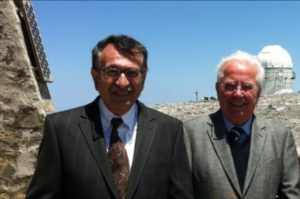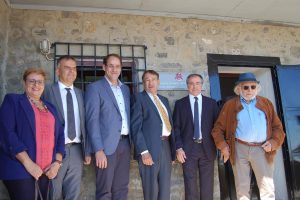Skinakas Observatory
The idea to create a site of astronomical research at Skinakas was conceived in the summer of 1984.  Soon after, the construction of a road to the mountain peak commenced. The University of Crete, the Foundation for Research and Technology – Hellas (FORTH, former Research Center of Crete) and the Max-Planck-Institut für Extraterrestrische Physik (MPE, Germany) agreed to build and operate together a telescope with the purpose of providing modern education in Astronomy to University students and also of supporting astronomical observations with emphasis on the research of extended sky objects like comets and gaseous nebulae. Prof. Ioannis Papamastorakis and Prof. Dr. Gerhard Haerendel, then Director of MPE, played a critical role in the creation of the observatory.
Soon after, the construction of a road to the mountain peak commenced. The University of Crete, the Foundation for Research and Technology – Hellas (FORTH, former Research Center of Crete) and the Max-Planck-Institut für Extraterrestrische Physik (MPE, Germany) agreed to build and operate together a telescope with the purpose of providing modern education in Astronomy to University students and also of supporting astronomical observations with emphasis on the research of extended sky objects like comets and gaseous nebulae. Prof. Ioannis Papamastorakis and Prof. Dr. Gerhard Haerendel, then Director of MPE, played a critical role in the creation of the observatory.
The expected arrival of Halley’s comet in the Spring of 1986, after 76 years of wandering through the solar system, set the time schedule for the installation of a Schmidt-Cassegrain telescope, which having a wide field of view, and equipped with a highly sensitive electronic camera was especially suited for the observation of the comet. Indeed, after the construction of the road on the rocky mountain and the completion of the first stone-made observatory, hundreds of people from all over Greece, among them many officials, came to Skinakas in the on April 12, 1986, in order to participate in the inauguration of the Observatory as well as to observe comet Halley. In 1988 the construction of the guesthouse, also made out of stone, was completed and immediately hosted the first school of Observational Astrophysics in Greece.
The successful installation and operation of the first small, 0.3m diameter telescope in a 3.2m dome built by Baader Planetarium GmbH, confirmed the excellent weather conditions at the top of Skinakas for high quality astronomical observations in the Mediterranean region. As a result the partner institutions decided to further develop the Observatory by installing a larger and more modern Ritchey-Chrétien type telescope with a primary mirror diameter of 1.3 meters. The telescope, which commenced operations in the fall of 1995, was placed in a metal building and a modern dome 8m in diameter, in order to minimize local thermal disturbances (atmospheric turbulence). The 1.3m telescope was built using high standards of sharpness and wide field of vision. These properties ensure excellent imagery and study of extended objects such as galaxies, star clusters and gaseous nebulae. To further improve the observation of extended objects, a focal reducer had been developed which nearly doubles the field of view while offering the possibility of spectroscopy.
As of 2000, the power needs of the observatory are served from a photovoltaic system which provides 11kW peak power and charges a flooded lead-acid battery system with a capacity of ~120 kW·h. Three full sine wave inverters from 48VDC to 220VAC (two 4KVA and one 10KVA) power the needs of the facility. In addition, two diesel generators, of 40kVA and 22kVA power respectively, are used in case of emergency.
In 2006, in collaboration with the University of Tuebingen, a third 0.6m telescope was installed at Skinakas Observatory. This Cassegrain telescope, called “Ganymede” is fully robotic and web-driven and has a 20′ x 20′ field of view. Due to severe damages of the building in the winter of 2013 the telescope was not used until May 2022 when a new building and a 5.3m Baader dome was installed at the same location. The telescope was decommissioned in November 2024, since it was replaced by the new 1.0m telescope.
On September 29 2019, the guesthouse of the observatory was officially renamed by the Rector of the Univ. of Crete, Prof. P. Tsakalides, to “Ioannis Papamastorakis Guest House“.  This honor recognized the seminal role of Ioannis Papamastorakis, Emeritus Professor of the Univ. of Crete and Director of Skinakas Observatory from 1984 until 2009, in conceiving the idea to create the first research observatory of a University in Greece and making it a reality. The event coincided with the 35 year anniversary of the founding of Skinakas Observatory, as well as 10 years since the retirement of Prof. Papamastorakis.
This honor recognized the seminal role of Ioannis Papamastorakis, Emeritus Professor of the Univ. of Crete and Director of Skinakas Observatory from 1984 until 2009, in conceiving the idea to create the first research observatory of a University in Greece and making it a reality. The event coincided with the 35 year anniversary of the founding of Skinakas Observatory, as well as 10 years since the retirement of Prof. Papamastorakis.
On November 20, 2024, a new fully robotic Ritchey-Chrétien telescope, with a primary mirror 1.0m in diameter, was installed at Skinakas Observatory. The telescope, which replaced the 0.6m telescope, was built by ASA Astrosysteme GmbH and its purchase was made possible thanks to a donation of the Committee “Greece 2021”.
The operation of Skinakas Observatory is supported by personnel of the Institute of Astrophysics – FORTH and of the Dept. of Physics, of the Univ. of Crete. Since 2025 its Director is Prof. Vasiliki Pavlidou.
Skinakas Observatory is located on top of the Ida mountain in Central Crete at an altitude of 1750m. Its Longitude is 24ο 53′ 57” East and its Latitude 35ο 12′ 43” North. The line-of-sight distance of Skinakas from the city of Heraklion is just 25km, a rather winding, though fully paved 50km drive by car, which takes a bit more than an hour. Along the road, nearly 20km before Skinakas, one passes by the historic town of Anogeia, which is well known for its significant role in the recent Cretan history. About 6 km northwest from the Observatory there is Ideon Andron, the cave where, according to the Greek mythology, Zeus the mighty Olympian god, grew up as an infant.
